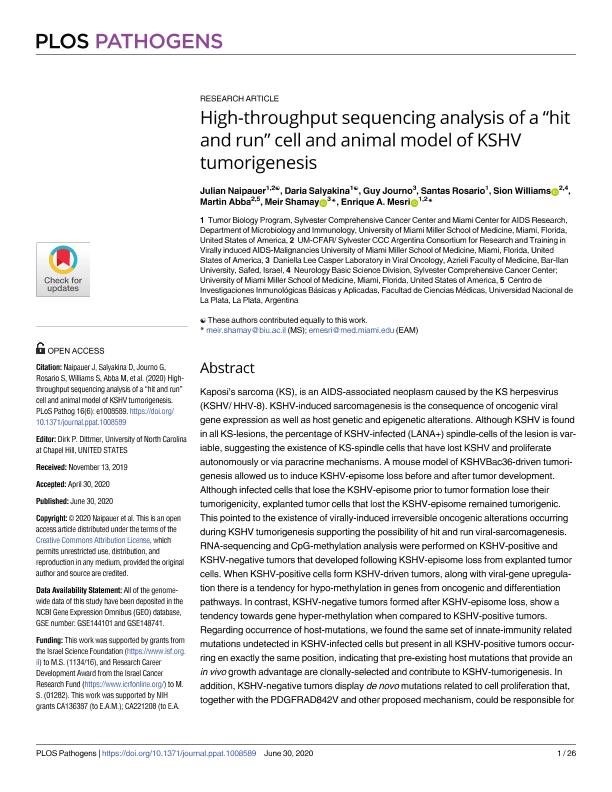Mostrar el registro sencillo del ítem
dc.contributor.author
Naipauer, Julian

dc.contributor.author
Salyakina, Daria
dc.contributor.author
Journo, Guy
dc.contributor.author
Rosario, Santas
dc.contributor.author
Williams, Sion
dc.contributor.author
Abba, Martín Carlos

dc.contributor.author
Shamay, Meir

dc.contributor.author
Mesri, Enrique Alfredo

dc.date.available
2021-09-09T19:21:52Z
dc.date.issued
2020-06
dc.identifier.citation
Naipauer, Julian; Salyakina, Daria; Journo, Guy; Rosario, Santas; Williams, Sion; et al.; High-throughput sequencing analysis of a “hit and run” cell and animal model of KSHV tumorigenesis; Public Library of Science; Plos Pathogens; 16; 6; 6-2020; 1-26
dc.identifier.issn
1553-7366
dc.identifier.uri
http://hdl.handle.net/11336/140042
dc.description.abstract
Kaposi's sarcoma (KS), is an AIDS-associated neoplasm caused by the KS herpesvirus (KSHV/ HHV-8). KSHV-induced sarcomagenesis is the consequence of oncogenic viral gene expression as well as host genetic and epigenetic alterations. Although KSHV is found in all KS-lesions, the percentage of KSHV-infected (LANA+) spindle-cells of the lesion is variable, suggesting the existence of KS-spindle cells that have lost KSHV and proliferate autonomously or via paracrine mechanisms. A mouse model of KSHVBac36-driven tumorigenesis allowed us to induce KSHV-episome loss before and after tumor development. Although infected cells that lose the KSHV-episome prior to tumor formation lose their tumorigenicity, explanted tumor cells that lost the KSHV-episome remained tumorigenic. This pointed to the existence of virally-induced irreversible oncogenic alterations occurring during KSHV tumorigenesis supporting the possibility of hit and run viral-sarcomagenesis. RNA-sequencing and CpG-methylation analysis were performed on KSHV-positive and KSHV-negative tumors that developed following KSHV-episome loss from explanted tumor cells. When KSHV-positive cells form KSHV-driven tumors, along with viral-gene upregulation there is a tendency for hypo-methylation in genes from oncogenic and differentiation pathways. In contrast, KSHV-negative tumors formed after KSHV-episome loss, show a tendency towards gene hyper-methylation when compared to KSHV-positive tumors. Regarding occurrence of host-mutations, we found the same set of innate-immunity related mutations undetected in KSHV-infected cells but present in all KSHV-positive tumors occurring en exactly the same position, indicating that pre-existing host mutations that provide an in vivo growth advantage are clonally-selected and contribute to KSHV-tumorigenesis. In addition, KSHV-negative tumors display de novo mutations related to cell proliferation that, together with the PDGFRAD842V and other proposed mechanism, could be responsible for driving tumorigenesis in the absence of KSHV-episomes. KSHV-induced irreversible genetic and epigenetic oncogenic alterations support the possibility of “hit and run” KSHV-sarcomagenesis and point to the existence of selectable KSHV-induced host mutations that may impact AIDS-KS treatment.
dc.format
application/pdf
dc.language.iso
eng
dc.publisher
Public Library of Science

dc.rights
info:eu-repo/semantics/openAccess
dc.rights.uri
https://creativecommons.org/licenses/by/2.5/ar/
dc.subject
KSHV
dc.subject
KAPOSI
dc.subject
SARCOMA
dc.subject
ONCOGENOMICS
dc.subject.classification
Biología Celular, Microbiología

dc.subject.classification
Ciencias Biológicas

dc.subject.classification
CIENCIAS NATURALES Y EXACTAS

dc.title
High-throughput sequencing analysis of a “hit and run” cell and animal model of KSHV tumorigenesis
dc.type
info:eu-repo/semantics/article
dc.type
info:ar-repo/semantics/artículo
dc.type
info:eu-repo/semantics/publishedVersion
dc.date.updated
2021-09-06T17:06:39Z
dc.identifier.eissn
1553-7374
dc.journal.volume
16
dc.journal.number
6
dc.journal.pagination
1-26
dc.journal.pais
Estados Unidos

dc.journal.ciudad
San Francisco
dc.description.fil
Fil: Naipauer, Julian. University of Miami; Estados Unidos. Consejo Nacional de Investigaciones Científicas y Técnicas. Centro Científico Tecnológico Conicet - La Plata; Argentina
dc.description.fil
Fil: Salyakina, Daria. University of Miami; Estados Unidos
dc.description.fil
Fil: Journo, Guy. Bar-Ilan University; Israel
dc.description.fil
Fil: Rosario, Santas. University of Miami; Estados Unidos
dc.description.fil
Fil: Williams, Sion. University of Miami; Estados Unidos
dc.description.fil
Fil: Abba, Martín Carlos. University of Miami; Estados Unidos. Universidad Nacional de La Plata. Facultad de Ciencias Médicas. Centro de Investigaciones Inmunológicas Básicas y Aplicadas; Argentina. Consejo Nacional de Investigaciones Científicas y Técnicas. Centro Científico Tecnológico Conicet - La Plata; Argentina
dc.description.fil
Fil: Shamay, Meir. Bar-Ilan University; Israel
dc.description.fil
Fil: Mesri, Enrique Alfredo. University of Miami; Estados Unidos
dc.journal.title
Plos Pathogens

dc.relation.alternativeid
info:eu-repo/semantics/altIdentifier/url/https://journals.plos.org/plospathogens/article?id=10.1371/journal.ppat.1008589
dc.relation.alternativeid
info:eu-repo/semantics/altIdentifier/doi/https://doi.org/10.1371/journal.ppat.1008589
Archivos asociados
